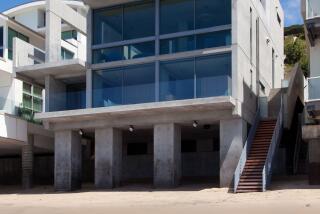Putting Their House in Order
- Share via
ORANGE, Va. — Thousands flock to the home of James Madison every season hoping to envision the scenes of his life: his Virginia youth, the constitutional studies undertaken in the upstairs library, the drawing-room conversations animated by the likes of Thomas Jefferson and Daniel Webster.
What they experience is a clash of centuries.
The original Madison house has been wrapped by additions put up roughly a century later by heirs of the Du Pont industrial fortune who purchased the site in 1901 and more than doubled the house’s size. The historical gap is revealed on the main floor: Three rooms are furnished to represent the Du Ponts’ time, and four rooms represent the Madisons’ era.
Now, as a new and exhaustive architectural investigation gets underway to outline the original layout of Madison’s home, the guardians of Montpelier face a monumental decision about whether the national landmark should be restored to its Madisonian origins through the obliteration of the vast Du Pont work.
The prospect of a massive demolition at the 55-room Montpelier estate has been the subject of passionate, on-and-off debate since the Du Pont family bequeathed the property to the National Trust for Historic Preservation in 1984.
“You can’t create the aura of the James Madison house with the Du Pont wings stuck on,” said Ralph Ketcham, a Syracuse University professor emeritus and Madison biographer.
Many historians and guests think the property should be arranged solely to present what they consider to be its most important story: the life of the “Father of the Constitution” and the nation’s fourth president. In their view, the $750,000 investigation now underway, which includes an examination of everything from paint chips to wood framing, will allow an accurate restoration, and the Du Pont alterations should not be allowed to interfere with a visitor’s experience.
“There is no federal monument to James Madison, and he is not on the currency, so if you want to honor him, this is it,” said Michael Quinn, president of the Montpelier Foundation, which manages the property and is adopting a neutral stance. “The purpose of this investigation is to make a defensible, well-reasoned decision.”
Opposition to the demolition is likely to come from two influential camps.
Henry du Pont, grandson of William du Pont, the family member who purchased and enlarged the house, stipulated before transfer of the property to the National Trust that two large Du Pont-era rooms on the main floor be preserved as a memorial to his grandfather and furnished in the Edwardian style favored during his grandfather’s time.
The National Trust is legally obliged to consider the views of Henry du Pont and his wife, Martha, about any preservation and restoration efforts. “It’s unrealistic to think that you can restore it to the little house it was,” Martha du Pont said. “What we want to make sure of is that William du Pont is not forgotten. He cared enough to buy a broken-down house and save it.”
She expressed anger at the National Trust, which she said had “stolen” the property from the family by having her husband’s elderly aunt sign papers. But, she said: “I don’t think the family would give them a great big fight if they want to give it more of a Madison feel.”
Second, regardless of the stance that Henry and Martha du Pont take on demolition, some preservationists argue that any major alteration to the property to re-create Madison’s house would amount to a betrayal of historical truth and risks destroying elements that could be valuable in the future.
“What is there at Montpelier today is enormously important--it is what really happened,” said W. Brown Morton, professor of historic preservation at Mary Washington College in Fredericksburg, Va., and co-author of the federal preservation guidelines, “Standards for Historic Preservation Projects.”
Morton said recently: “When you start manipulating what is there in a theatrical way, then you end up with what never happened.”
Few, however, dispute that Madison’s era was the most important in Montpelier’s long history, and the exhibits there have gradually focused more and more on that era.
Montpelier was Madison’s lifelong home and evolved in step with his family and career. The earliest portion was built by his father about 1760, when James was a boy of 9; after he married Dolley in 1794, Madison expanded the home and added a classical front portico. Another expansion occurred between 1809 and 1812.
Biographers depict countless scenes at Montpelier that moved Madison and, in turn, the course of history.
In the upstairs library, for example, they picture him in 1786 poring over cartons of books sent by Jefferson, studying the failures of past governments. It was there that he is believed to have written “Notes on Ancient and Modern Confederacies,” a cram session that would inform his monumental work at the constitutional conventions and in the Federalist Papers.
“Since I have been at home, I have had the leisure to review the literary cargo for which I am so much indebted to your friendship,” he wrote to Jefferson from his estate in March 1786. “If anything comes of the convention, it will probably be of a permanent, not a temporary, nature, which I think will be a great point.”
The architectural revisions to the Madison property that now bedevil investigators began after Dolley Madison sold the home in 1844, eight years after her husband’s death. The property changed hands several times before William du Pont purchased it in 1901 and, in an attempt to create an English country house, began major renovations to the sides and back of the house.
The last Du Pont to live at Montpelier, Marion du Pont, William’s daughter, directed in her will that the home be turned over to the National Trust and converted into a Madison shrine. However, her nephews Henry and John du Pont contested her wishes in court, and the negotiated settlement in 1984 called for the National Trust to keep the “memorial” rooms honoring William du Pont.
For now, the question of whether Montpelier should be returned to its Madisonian origins turns on two largely subjective questions: How much evidence is needed to ensure that the restoration is authentic? And even if it can be done authentically, should it be done?
Cost estimates in the past have reached $40 million.
Representatives of the National Trust and the Montpelier Foundation, the private nonprofit group that manages the property, declined to speculate about Montpelier’s future.
“There is a feeling that we would be better served if the house were more in the configuration that was there when Madison was there,” said William Lewis, a Washington lawyer who is chairman of the Montpelier Foundation. “But we won’t have any final answers until after the investigation is done.”


